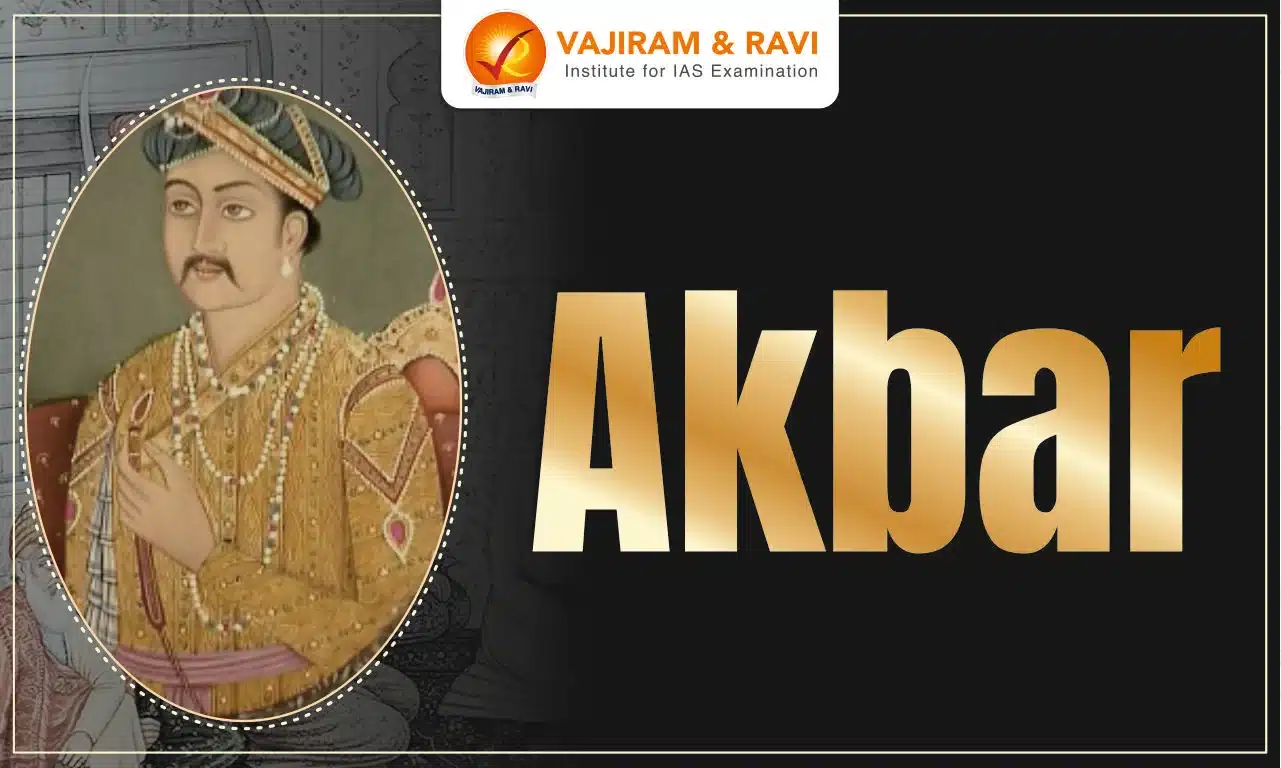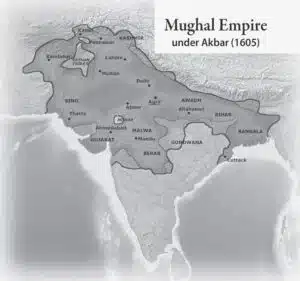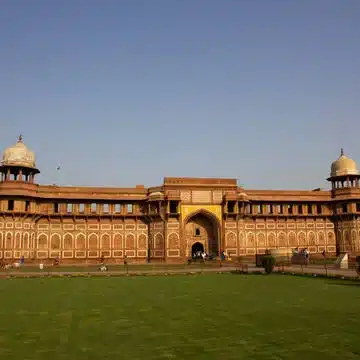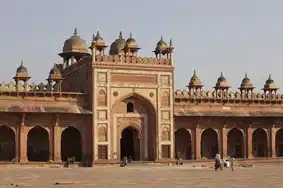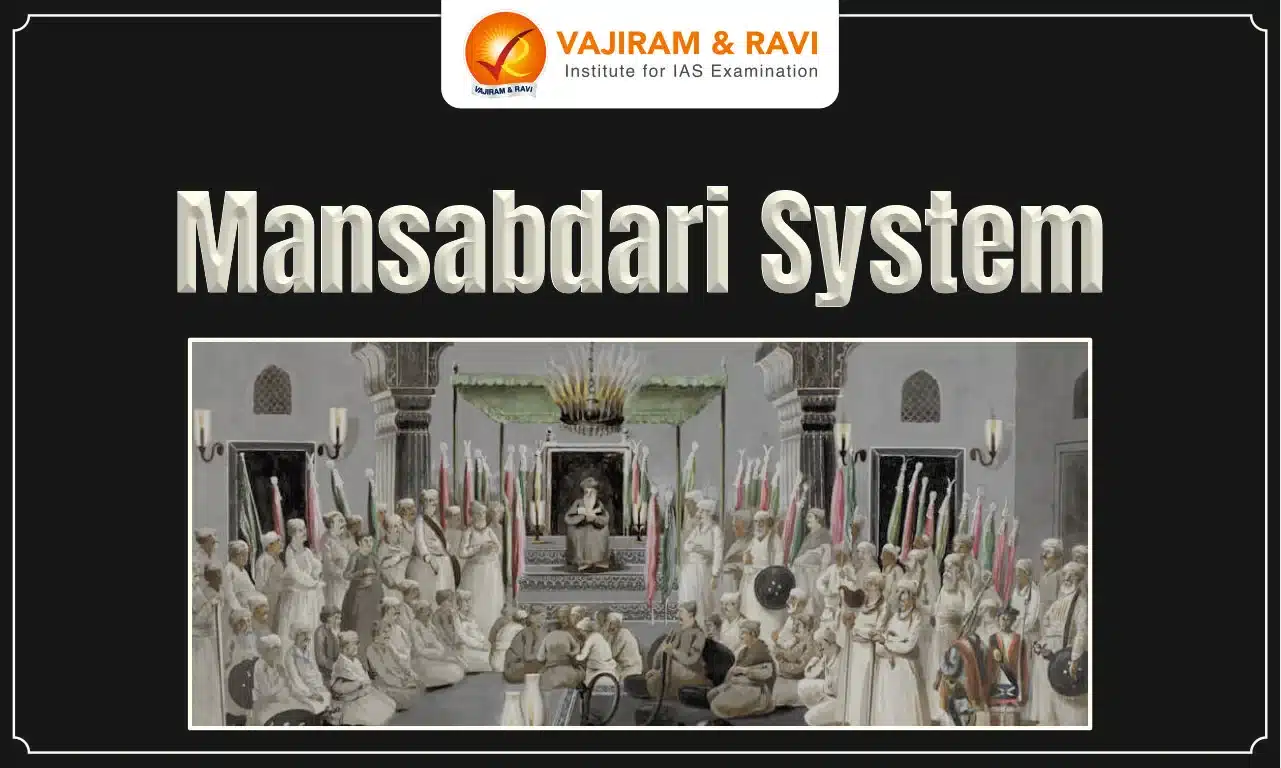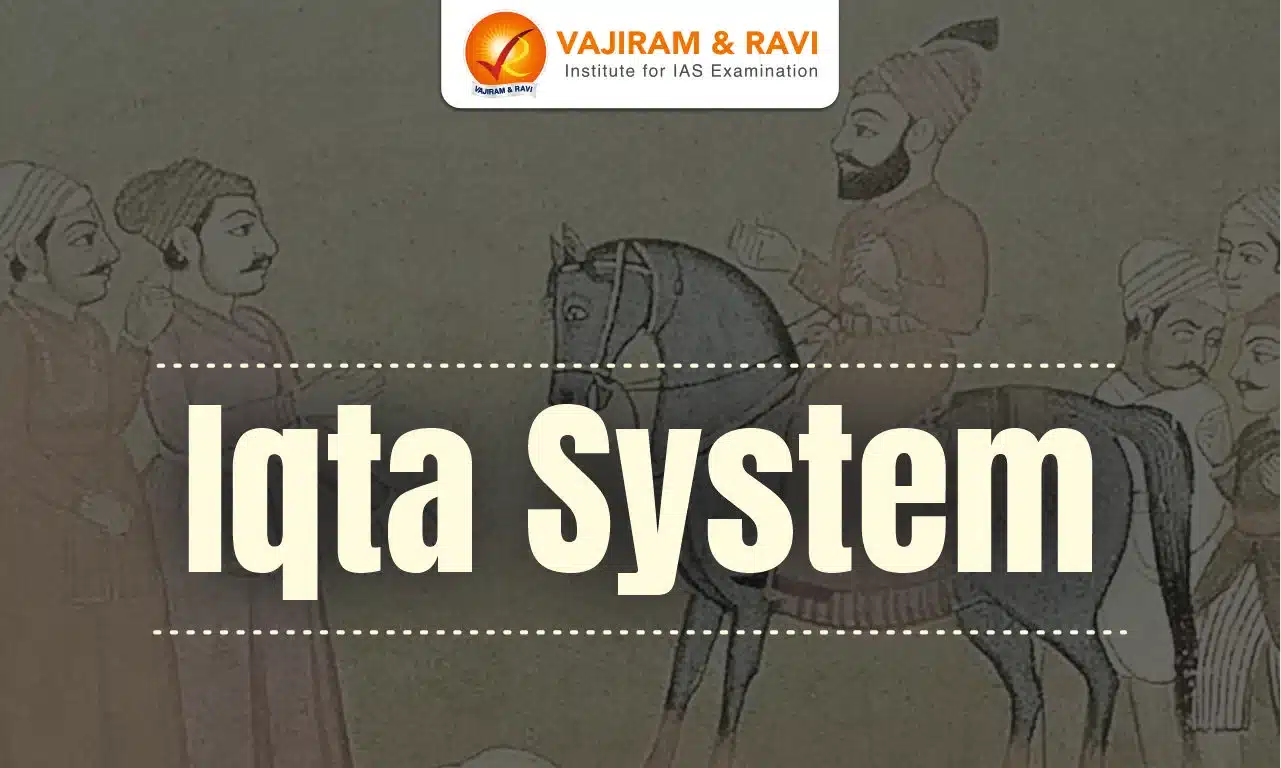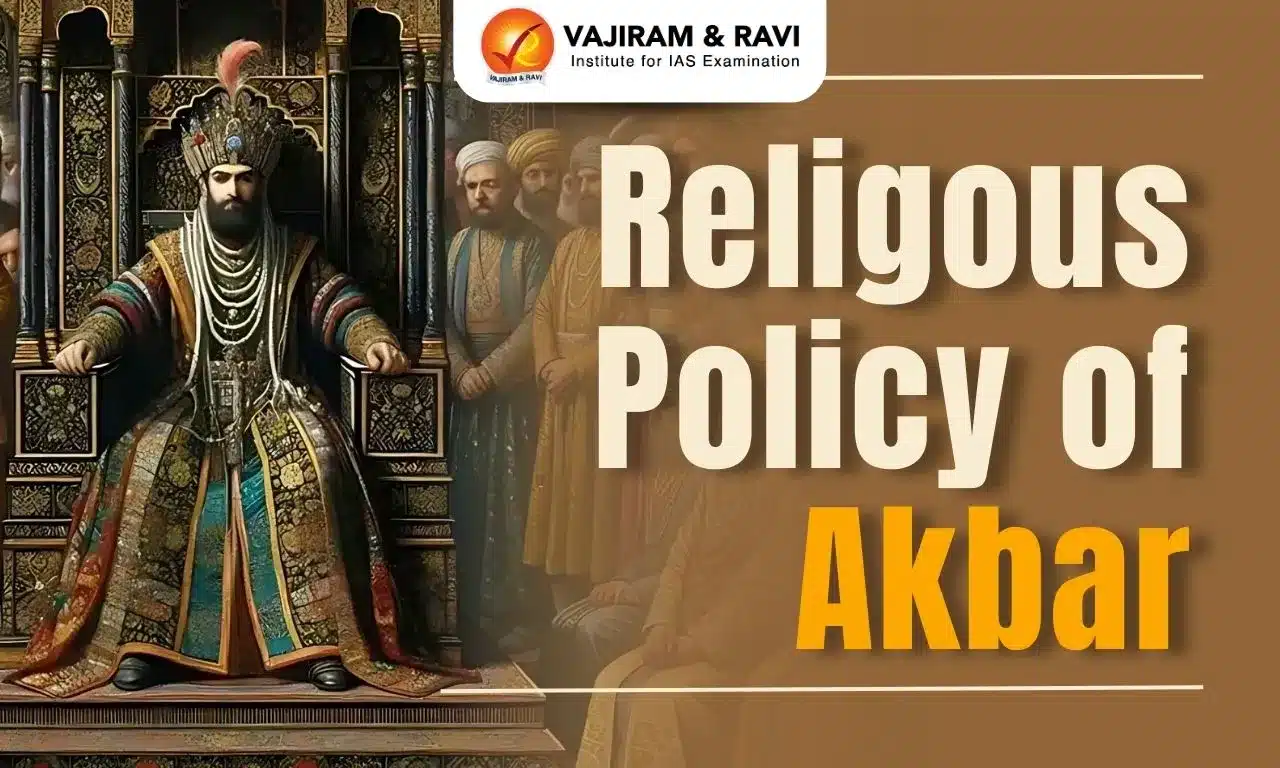Akbar (1556–1605) was the third ruler of the Mughal Dynasty. Akbar succeeded his father Humayun at the age of 13 and helped to expand the Mughal Empire. Akbar’s military, political, cultural, and economic dominance helped him gain dominance in the Indian subcontinent. Akbar established a centralized administration, conciliated conquered rulers and gained non-Muslim support through his Religious and Rajput policies.
Akbar’s rule led to a stable economy and helped in the development of art and architecture, including notable literary works like Akbarnama. Akbar's patronage of painters and religious tolerance aided the Mughal Empire's growth.
About Akbar
Akbar's real name was Abu’l-Fath Jala-ud-din Muhammad. Akbar was the third ruler of the Mughal Dynasty. He was born on October 15, 1542, in Umarkot, now in Sindh province, Pakistan. Akbar was the grandson of Babur and the son of Humayun and Hamida Banu Begum. Akbar succeeded his father, Humayun, in 1556. Bairam Khan enthroned 13-year-old Akbar and proclaimed him Shehanshah.

Akbar Military Conquests
Akbar’s military campaigns were the foundation of his attempt to consolidate the Mughal Empire. His conquests extended throughout several parts of India, considerably expanding the empire’s territory.
- Northern India: Akbar defeated Hemu in the Second Battle of Panipat in 1556 to secure his throne and consolidate power in Delhi and Agra.
- Jaunpur, ruled by Afghans, was annexed to the Mughal Empire during the first expedition (1559-60) led by Khan Zaman to Gwalior and Jaunpur.
- Central India: Ram Shah Tomar surrendered Gwalior Fort when Akbar sent his first expedition (1559-60).
- Akbar conquered Malwa in 1561, defeating Baz Bahadur in the Battle of Sarangpur.
- Garh Katanga or Gondwana, ruled by Rani Durgawati, was conquered in 1564.
- Akbar also suppressed Uzbeg-led revolts led by Khan Uzbeg and also ended conflicts with nobility, which started after the dismissal of Bairam Khan.
- Western India: The campaigns in Western India were primarily intended to subjugate the Rajputs and secure lucrative trade routes in Gujarat.
- Conquest of Rajputana: Akbar's military campaigns in Rajputana resulted in the siege of Chittorgarh in 1567. In 1568, Akbar captured the Fort of Ranthambore. Except for Chittor's King Maharana Pratap, the majority of Rajput kingdoms joined Mughal nobility and supported Akbar's expansion.
- Conquest of Gujarat: Akbar annexed Gujarat in 1573, which was important for maritime trade.
- Eastern India: Akbar annexed Bengal in 1576 after defeating Daud Khan Karrani and bringing it under Mughal control.
- Akbar suppressed the widespread revolts in Bengal and Bihar, which were sparked by Afghans and due to his strict jagir reforms.
- North-West India: Akbar aimed to settle rebellions and conquer new territories in the North-West regions.
- Suppression of Roshanais: Akbar defeated the Roshanais in 1585, who rebelled and blocked the Kabul-Hindustan route, securing the North West frontier.
- Conquest of Kashmir: In 1586, Akbar defeated the King of Kashmir Yusuf Khan, and annexed the region.
- Deccan and Southern India: Akbar initiated a Deccan policy in 1590 to subjugate Ahmednagar, Bijapur, and Golconda.
-
- Mughal forces besieged Ahmednagar in 1595, finally leading to a treaty in which Chand Bibi ceded Berar.
- Akbar captured Ahmednagar, Burhanpur, Asirgarh, and Berar by 1600.
Akbar Military Innovations
Akbar strengthened the Mughal army by introducing various military innovations. These included the implementation of a centralized command system, new weaponry, and tactics.
- Professionalization: Akbar focused on the formation of a professional army comprising various ethnic groups, including Mughals, Afghans, Rajputs, and Iranians.
- Use of Matchlock: The Introduction of the matchlock musket (bandook) and improvements were made to it by Akbar.
- Cannons: Akbar encouraged the use of cannons in warfare
- Mansabdari system: It was implemented to maintain a large and well-equipped army.
Mansabdari System
Akbar implemented the Mansabdari system, which classified nobles and military officers based on ranks (mansabs) and responsibilities. Each Mansab was required to maintain a specific number of cavalrymen. It helped to maintain a disciplined and well-organized army. Akbar created the Mansabdari System with 66 grades, from a commander of ten (dehbhasi) to the commander of ten thousand (dahhazari).
Akbar Administration
Akbar’s administrative reforms were crucial in constructing a consolidated and efficient governance structure. His policies provided the groundwork for the Mughal Empire's long-term stability and success.
Political Structure of Akbar’s Administration
Akbar centralized power by dividing the empire into Subahs or provinces. Each subah was governed by a Subedar responsible for maintaining law and order, revenue collection, and military defense. The political structure can be divided into various levels, such as central, provincial, District/Sarkar, Pargana, Village, etc. The structure is discussed in detail below:
- Central Administration: The centre of the whole structure was sovereign.
- Important functionaries included Wazir, Diwan (Income and expenditure controller), Mir Bakshi (Head of Military), Mir Saman (In charge of imperial household), Sadr-us-sadr (In charge of charitable & religious endowment), Qazi-ul-Qujat (Head of Judiciary), and Waqia Navis (News Reporters/writers).
- Provincial Administration: Akbar made a division and systematic organization of the empire into different provinces or subas. Their number was fifteen at the time of death of Akbar.
- Important Functionaries included Sipahsalar (head executive), Diwan (In charge of revenue department), Bakshi (In charge of military department), Sadr (In charge of judicial department).
- Local Administration: The Mughal Empire was divided into Subah or Province, which was further subdivided into Sarkars, Parganas, and villages.
- Sarkar had functionaries like Fauzdar (administrative head), Amalguzar (Revenue Collection), Kotwal (Law & Order)
- Pargana had functionaries like Shiqdar(Administratrive head), Amin & Qanungo (Revenue officials)
- Village had functionaries like Muqaddam (Headman), Patwari (Accountant), Chowkidar (Watchman)
Akbar’s Revenue and Land Administration Policy
Akbar’s finance minister, Todarmal, introduced two new systems of land revenue collection, namely the Zabti system and the Dahshala System.
- Zabti System: The zabti system, implemented during Akbar's reign, required land measurement and fixed cash revenue rates (dastur) for each crop, and all collection was conducted in cash.
- Dahshala System: It was a revenue collection system that changed the land measurement method from ropes to bamboo pieces connected by iron rings, called the Bamboo Jarid System. The government collected revenue based on the ten-year crop average. This system divided land into four categories:
- Polaj: Land which was cultivated annually.
- Parauti: Land which was left fallow for a short period of 1 or 2 years.
- Chachar: Land which was left fallow for 3 to 4 years.
- Banjar: Uncultivated for 5 years or more.
Jagirdari System
During Akbar’s period, the territory was broadly divided into two categories: Khalisa and Jagir. The revenue from the Khalisa went to the Imperial treasury, while that from the Jagir was assigned to the Jagirdars instead of their salaries, based on their ranking. Jagirdars were in charge of collecting revenue, maintaining order, and managing the land. This structure enabled flexible land redistribution to maximize productivity and ensure efficient administration across the empire.
Akbar Judicial Reform
Akbar abolished laws that discriminated against non-Muslims and created a single legal system that incorporated laws from both Islam and Hinduism.
- Equality in Court: Akbar elevated the Hindu court system to an official status alongside Muslim law.
- Promoted Common Laws: Akbar reformed laws to ensure fair treatment for citizens of all religions and maximize the use of common laws for Muslim and Hindu citizens.
- Issue of Mahzar: In 1579, he issued a decree designating himself as the supreme authority on religious questions, encouraging dialogue between academics of all religions.
Akbar Rajput Policy
Akbar approached the Rajputs through diplomacy and alliance formation, such as marrying Rajput princess Harkha Bai. In return for their loyalty, he gave them prominent posts in his court and allowed them to keep their independence.
- Matrimonial Alliance: Akbar forged matrimonial and diplomatic ties to form alliances with Rajput states.
- High Posts: Rajput chiefs were given high ranks in the Mansabdari system.
- Non-interference: Akbar gave Rajputs sovereignty over their internal affairs and allowed them to keep their territories.
Akbar Religious Policies
Akbar is known for his policy of religious tolerance and his endeavors to promote harmony among different communities. He made religion and state separate entities, allowing people of all faiths to hold government positions.
- Religious Tolerance: Akbar abolished Jizya (poll tax) on non-Muslims in 1564. He also abolished the forced conversion of prisoners of war to Islam.
- Sulh-i-Kul: Akbar promoted Sulh-i-Kul (political and spiritual unification of the country), a policy of universal tolerance.
- Ibadat Khana: Akbar established Ibadat Khana (House of Worship) in Fatehpur Sikri, where he held discussions with academics from different religions.
- Din-i-Ilahi: Akbar introduced Din-i-Ilahi (Divine faith), a new religion that blended aspects of Islam, Hinduism, and others in 1582.
Akbar Art and Literature
Akbar’s long, peaceful, and prosperous reign led to unprecedented growth in art and literature, reflecting his magnanimity and liberalism. During Akbar's reign, Mughal Art and culture flourished, blending indigenous and foreign influences, resulting in a distinct Indo-Islamic style.
- Literature: Akbar’s court was renowned for its opulence and broad support of its scholars, musicians, and artists. Some of the intellectual contributions are:
- Ain-i-Akbari by Abu’l Fazl
- Akbarnama by Faizi
- Library: Akbar created a Kitab Khana for storing his manuscripts.
- Translations: Akbar established Maktab Khana (House of Translations) in Fatehpur Sikri in 1574, and he also commissioned the translation of important books such as:
- The translation of the Mahabharata into Persian, known as the Razmnama (Book of War), began in 1582-84. This was completed in 1589 under the supervision of master artist Daswant.
- Yogavasistha, also known as Maha-Ramayana, is a significant Hindu philosophical text translated into Persian by Nizamuddin Panipati, Akbar's Mir Bakshi.
- Sanskrit mathematical text "Lilavati" by Bhaskaracharya was translated into Persian by Akbar's poet laureate, Faizi.
- Calligraphy: Muhammad Husayn al-Katib Kashmiri, a renowned calligrapher at Emperor Akbar's court, was awarded the title "Zarrin Qalam" (Golden Pen) for his exceptional skills.
- Patronage of Art: According to Abul Fazal, Akbar's court historian, the royal atelier employed over a hundred artists. Akbar personally interacted with the artists, supervising and evaluating their work.
- Daswant and Basawan were famous painters in Akbar's court.
- Paintings: During Akbar's reign, Mughal painting emerged as a distinct style, blending Persian and Indian traditions, with key projects like the "Hamzanama" showcasing the development of this unique art form.
- Coins: Akbar issued coins in gold, silver, and copper; these were called Muhar, rupiya, dam or falus or tanka, respectively. The gold and silver coins were issued in the weight standard of about 11-11.5 gm with their denominations. Dams or falus weighed approximately 20 gm.
Akbar Navratna
Akbar’s Navratnas were nine distinguished courtiers who had a profound impact on his administration, culture, and diplomacy. They included the following:
|
Navratna |
Description |
|
Abul Fazl |
Akbar’s chief advisor and the author of Akbarnama. |
|
Faizi |
A Persian poet who composed over a hundred poetic works in Persian. |
|
Tansen |
- A renowned musician, vocalist, composer, and instrumentalist of Hindustani Classical Music.
|
|
Birbal |
He was a poet, singer, and wise advisor known for being extremely clever and witty. |
|
Raja Todar Mal |
He was the Finance minister |
|
Raja Man Singh |
He was a mansabdar who led key military campaigns for Emperor Akbar. |
|
Abdul Rahim Khan-i-Khana |
He wrote various dohas and translated Babar’s Babarnama into Persian. |
|
Mulla Do-Pyaza |
Minister of Home Affairs and was in charge of the country’s internal security. |
|
Fakir Aziao-Din |
Chief advisor in Emperor Akbar’s Court and used to advise on religious matters. |
Akbar Architecture
Akbar’s architecture demonstrated his liberal and tolerant views. It was a masterful fusion of Islamic and Indo-Pacific styles. His buildings mainly used red sandstone as a building material. Some of his architectural contributions are :
- Agra Fort: Akbar built a historical fort in Agra known as Agra Fort or Qila-i-Akbari. It's a UNESCO World Heritage Site.
- Fatehpur Sikri: Akbar built Fatehpur Sikri as the Mughal Empire's capital, also known as the City of Victory, which is a UNESCO World Heritage site. It Includes:
- Buland Darwaza: It is constructed of red and yellow sandstone with a white marble inlay outline. It was built to commemorate Akbar’s conquest of Gujarat.
- Jama Masjid: It features a central courtyard, arcades on three sides, a domed prayer hall, and a big gateway at the east side entrance.
- Tomb of Salim Chisti: It was built in 1581 and showcases exquisite marble work and intricate carvings.
- Jodha Bai’s Palace: It is the largest building in the complex. It features plain exterior walls, an arcaded passage, and roofs covered with bright blue glazed tiles from Multan.
- Diwani-Khas: The most distinctive administrative building. It features a rectangular plan, a central column with connecting railed bridges, and a flat roof.
- Panch Mahal: It is a five-story building with unique columns, a domed kiosk, and diminishing levels as one goes upwards.
- Temple of Govind Dev: It was built in Vrindavan by Raja Man Singh, a leading nobleman at Akbar's court, with the support of the Mughal emperor
- Nilkanth Temple: Nilkanth Temple, also known as Imarat-i-Dilkhusha (meaning "heart-pleasing abode"), is a Mughal-style temple built in Mandu, Madhya Pradesh. It was built by the governor Shah Badgah on the orders of Mughal Emperor Akbar in 1574 for his Hindu wife, Empress Mariam-uz-Zamani (also known as Jodha Bai).
Akbar Death
Akbar died on 25 October 1605, due to dysentery in Agra. He had brought two-thirds of the Indian sub-continent into an empire, including Afghanistan, Kashmir, and present-day India and Pakistan. Akbar was acclaimed 'Lord of the Universe' by his subjects. His tomb is located in Sikandra, northwest of Agra. He was succeeded by his son, Jahangir.
Akbar UPSC PYQs
Q.1 "Yogavasistha" was translated into Persian by Nizamuddin Panipati during the reign of : (UPSC Prelims 2022)
(a) Akbar
(b) Humayun
(c) Shahjahan
(d) Aurangzeb
Ans. (a)
Q.2 With reference to Mian Tansen, which one of the following statements is not correct? (UPSC 2019)
- Tansen was the title given to him by Emperor Akbar.
- Tansen composed Dhrupads on Hindu gods and goddesses.
- Tansen composed songs on his patrons.
- Tansen invented many ragas.
Ans. (a)
Q.3 Consider the following statements: (UPSC 2019)
- Saint Nimbarka was a contemporary of Akbar.
- Saint Kabir was greatly influenced by Shaikh Ahmad Sirhindi.
Which of the statements given above is/are correct?
(a) 1 only (b) 2 only (c) Both 1 and 2 (d) Neither 1 nor 2
Ans. (d)
Q.4 With reference to the cultural history of India, consider the following statements:
- White Marble was used in making Buland Darwaza and Khankah at Fatehpur Sikri.
- Red Sandstone and marble were used in making Bara Imambara and Rumi Darwaza at Lucknow.
Which of the following statements given above is/are correct? (UPSC 2018)
- 1 only
- 2 only
- Both 1 and 2
- Neither 1 nor 2
Ans. (d)
Q.5 Ibadat Khana at Fatehpur Sikri was (UPSC Prelims 2014)
(a) The mosque for the use of Royal Family
(b) Akbar’s private prayer chamber
(c) The hall in which Akbar held discussions with scholars of various religions
(d) The room in which the nobles belonging to different religions gathered to discuss religious affairs.
Ans. (c)
Last updated on November, 2025
→ Check out the latest UPSC Syllabus 2026 here.
→ Join Vajiram & Ravi’s Interview Guidance Programme for expert help to crack your final UPSC stage.
→ UPSC Mains Result 2025 is now out.
→ UPSC Notification 2026 is scheduled to be released on January 14, 2026.
→ UPSC Calendar 2026 is released on 15th May, 2025.
→ The UPSC Vacancy 2025 were released 1129, out of which 979 were for UPSC CSE and remaining 150 are for UPSC IFoS.
→ UPSC Prelims 2026 will be conducted on 24th May, 2026 & UPSC Mains 2026 will be conducted on 21st August 2026.
→ The UPSC Selection Process is of 3 stages-Prelims, Mains and Interview.
→ UPSC Result 2024 is released with latest UPSC Marksheet 2024. Check Now!
→ UPSC Prelims Result 2025 is out now for the CSE held on 25 May 2025.
→ UPSC Toppers List 2024 is released now. Shakti Dubey is UPSC AIR 1 2024 Topper.
→ UPSC Prelims Question Paper 2025 and Unofficial Prelims Answer Key 2025 are available now.
→ UPSC Mains Question Paper 2025 is out for Essay, GS 1, 2, 3 & GS 4.
→ UPSC Mains Indian Language Question Paper 2025 is now out.
→ UPSC Mains Optional Question Paper 2025 is now out.
→ Also check Best IAS Coaching in Delhi
Akbar FAQs
Q1. Why is Akbar so famous?+
Q2. Why is Akbar called the Great?+
Q3. What were Akbar’s major Military conquests?+
Q4. Who replaced Akbar?+
Q5. When did Akbar die and why?+
Tags: quest UPSC Medieval History



